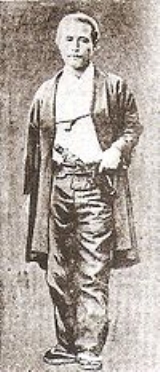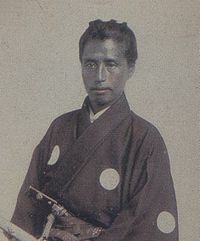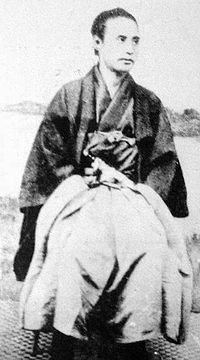
Katsu Kaishu
Encyclopedia
was a Japanese statesman, naval engineer during the Late Tokugawa shogunate
and early Meiji period
. Kaishū was a nickname which he took from a piece of calligraphy (Kaishū Shooku ) by Sakuma Shōzan
. He went through a series of given name
s throughout his life; his childhood name was and his real name was . He was often called from his title during the late Tokugawa shogunate
and changed his name to after the Meiji Restoration
.
Katsu Kaishū eventually rose to occupy the position of commissioner (Gunkan-bugyō) in the Tokugawa navy. He is particularly known for his role in the surrender of Edo
.
(present day Tokyo
) to a low-ranking retainer of the Tokugawa
Shogun
. His father, Katsu Kokichi
, the subject of the autobiography, Musui's Story, was the ill-behaved head of a minor samurai family, who was forced to abdicate the headship of his family to Rintarō/Kaishū when the latter was only 15. As a youth Katsu studied Dutch
and European military science, and was eventually appointed translator by the government when European powers attempted to open contact with Japan. Katsu developed the reputation as an expert in western military technology.
Under the advisement of Dutch advisors, he served as director of training for the Nagasaki Naval Center together with Nagai Naoyuki
between 1855 until 1859 when he was commissioned an officer in the shogunal navy the following year.
 In 1860, Katsu was assigned to command the Kanrin-maru, and (with assistance from US naval officer Lt. John M. Brooke), to escort the first Japanese delegation to San Francisco, California
In 1860, Katsu was assigned to command the Kanrin-maru, and (with assistance from US naval officer Lt. John M. Brooke), to escort the first Japanese delegation to San Francisco, California
en route to Washington, DC for the formal ratification of the Harris Treaty. The Kanrin Maru, built by the Dutch
, was Japan's first steam-powered warship, and its voyage across the Pacific Ocean
was meant to signal that Japan had mastered modern sailing and shipbuilding technology. Kaishū remained in San Francisco for nearly two months, observing American society, culture and technology. Following returning to Japan, Katsu held a series of high ranking posts in the Tokugawa navy, arguing before government councils in favor of a unified Japanese naval force led by and professionally trained officers in disregard of promotion and assignment due to hereditary status. During his command as director of the Kobe Naval School, the institute would become a major source of activity for progressive thinking and reformists between 1863 and 1864.
In 1866, Katsu was appointed negotiator between the bakufu forces and the anti-shogunal domain of Chōshū
, and later served as chief negotiator for the Tokugawa bakufu, ensuring a relatively peaceful and orderly transition of power in the Meiji Restoration
.
Although sympathetic to the anti-Tokugawa cause, Katsu remained loyal to the Tokugawa bakufu during the Boshin War
. After the collapse of the Tokugawa forces in late 1867, Katsu negotiated the surrender of Edo castle to Saigō Takamori
and the Satchō Alliance
on 11 April 1868. Katsu followed the last Shōgun
, Tokugawa Yoshinobu
, into exile in Shizuoka
.
in 1872, followed by first Minister of the Navy from 1873 until 1878. He was the most prominent of the former Tokugawa retainers who found employment with in the new Meiji government, and was between 1869 and 1885 who did not come from one of the four paramount domains. Although his influence within the navy was minimal, as the Navy was largely dominated by a core of Satsuma officers, Katsu served in a senior advisory capacity on national policy. During the next two decades, Katsu served on the Privy Council
and wrote extensively on naval issues before his death in 1899.
In 1887, he was elevated to the title of hakushaku (count) in the kazoku
peerage system.
 Katsu recorded his memoirs in the book Hikawa Seiwa.
Katsu recorded his memoirs in the book Hikawa Seiwa.
Late Tokugawa shogunate
, literally "end of the curtain", are the final years of the Edo period when the Tokugawa shogunate came to an end. It is characterized by major events occurring between 1853 and 1867 during which Japan ended its isolationist foreign policy known as sakoku and transitioned from a feudal shogunate...
and early Meiji period
Meiji period
The , also known as the Meiji era, is a Japanese era which extended from September 1868 through July 1912. This period represents the first half of the Empire of Japan.- Meiji Restoration and the emperor :...
. Kaishū was a nickname which he took from a piece of calligraphy (Kaishū Shooku ) by Sakuma Shōzan
Sakuma Shozan
sometimes called Sakuma Zōzan, was a Japanese politician and scholar of the Edo era. He was the son of a samurai, and a native of Shinshu in today's Nagano-ken.From the age of 23, he went to Edo and for 10 years studied Chinese sciences ....
. He went through a series of given name
Given name
A given name, in Western contexts often referred to as a first name, is a personal name that specifies and differentiates between members of a group of individuals, especially in a family, all of whose members usually share the same family name...
s throughout his life; his childhood name was and his real name was . He was often called from his title during the late Tokugawa shogunate
Late Tokugawa shogunate
, literally "end of the curtain", are the final years of the Edo period when the Tokugawa shogunate came to an end. It is characterized by major events occurring between 1853 and 1867 during which Japan ended its isolationist foreign policy known as sakoku and transitioned from a feudal shogunate...
and changed his name to after the Meiji Restoration
Meiji Restoration
The , also known as the Meiji Ishin, Revolution, Reform or Renewal, was a chain of events that restored imperial rule to Japan in 1868...
.
Katsu Kaishū eventually rose to occupy the position of commissioner (Gunkan-bugyō) in the Tokugawa navy. He is particularly known for his role in the surrender of Edo
Edo
, also romanized as Yedo or Yeddo, is the former name of the Japanese capital Tokyo, and was the seat of power for the Tokugawa shogunate which ruled Japan from 1603 to 1868...
.
Early life
Katsu was born in EdoEdo
, also romanized as Yedo or Yeddo, is the former name of the Japanese capital Tokyo, and was the seat of power for the Tokugawa shogunate which ruled Japan from 1603 to 1868...
(present day Tokyo
Tokyo
, ; officially , is one of the 47 prefectures of Japan. Tokyo is the capital of Japan, the center of the Greater Tokyo Area, and the largest metropolitan area of Japan. It is the seat of the Japanese government and the Imperial Palace, and the home of the Japanese Imperial Family...
) to a low-ranking retainer of the Tokugawa
Tokugawa shogunate
The Tokugawa shogunate, also known as the and the , was a feudal regime of Japan established by Tokugawa Ieyasu and ruled by the shoguns of the Tokugawa family. This period is known as the Edo period and gets its name from the capital city, Edo, which is now called Tokyo, after the name was...
Shogun
Shogun
A was one of the hereditary military dictators of Japan from 1192 to 1867. In this period, the shoguns, or their shikken regents , were the de facto rulers of Japan though they were nominally appointed by the emperor...
. His father, Katsu Kokichi
Katsu Kokichi
was born Otani Kokichi in Edo. He was a low-ranking samurai who was adopted by the Katsu family in order to marry the only Katsu daughter, Nobuko. Kokichi's father, Otani Heizo, was a minor official in the shogunate. His half brother, Otani Hikoshiro, was twenty-five years older than Kokichi...
, the subject of the autobiography, Musui's Story, was the ill-behaved head of a minor samurai family, who was forced to abdicate the headship of his family to Rintarō/Kaishū when the latter was only 15. As a youth Katsu studied Dutch
Dutch language
Dutch is a West Germanic language and the native language of the majority of the population of the Netherlands, Belgium, and Suriname, the three member states of the Dutch Language Union. Most speakers live in the European Union, where it is a first language for about 23 million and a second...
and European military science, and was eventually appointed translator by the government when European powers attempted to open contact with Japan. Katsu developed the reputation as an expert in western military technology.
Under the advisement of Dutch advisors, he served as director of training for the Nagasaki Naval Center together with Nagai Naoyuki
Nagai Naoyuki
, also known as or , was a Japanese samurai and Tokugawa retainer during the Bakumatsu and Meiji periods.-Early life:Nagai Naoyuki, or as he was first known, , was born in the Nukada district of the Okutono Domain by a concubine to . Noritada, while head of a collateral branch of the Tokugawa, was...
between 1855 until 1859 when he was commissioned an officer in the shogunal navy the following year.
Military service

San Francisco, California
San Francisco , officially the City and County of San Francisco, is the financial, cultural, and transportation center of the San Francisco Bay Area, a region of 7.15 million people which includes San Jose and Oakland...
en route to Washington, DC for the formal ratification of the Harris Treaty. The Kanrin Maru, built by the Dutch
Netherlands
The Netherlands is a constituent country of the Kingdom of the Netherlands, located mainly in North-West Europe and with several islands in the Caribbean. Mainland Netherlands borders the North Sea to the north and west, Belgium to the south, and Germany to the east, and shares maritime borders...
, was Japan's first steam-powered warship, and its voyage across the Pacific Ocean
Pacific Ocean
The Pacific Ocean is the largest of the Earth's oceanic divisions. It extends from the Arctic in the north to the Southern Ocean in the south, bounded by Asia and Australia in the west, and the Americas in the east.At 165.2 million square kilometres in area, this largest division of the World...
was meant to signal that Japan had mastered modern sailing and shipbuilding technology. Kaishū remained in San Francisco for nearly two months, observing American society, culture and technology. Following returning to Japan, Katsu held a series of high ranking posts in the Tokugawa navy, arguing before government councils in favor of a unified Japanese naval force led by and professionally trained officers in disregard of promotion and assignment due to hereditary status. During his command as director of the Kobe Naval School, the institute would become a major source of activity for progressive thinking and reformists between 1863 and 1864.
In 1866, Katsu was appointed negotiator between the bakufu forces and the anti-shogunal domain of Chōshū
Nagato Province
, often called , was a province of Japan. It was at the extreme western end of Honshū, in the area that is today Yamaguchi Prefecture. Nagato bordered on Iwami and Suō Provinces....
, and later served as chief negotiator for the Tokugawa bakufu, ensuring a relatively peaceful and orderly transition of power in the Meiji Restoration
Meiji Restoration
The , also known as the Meiji Ishin, Revolution, Reform or Renewal, was a chain of events that restored imperial rule to Japan in 1868...
.
Although sympathetic to the anti-Tokugawa cause, Katsu remained loyal to the Tokugawa bakufu during the Boshin War
Boshin War
The was a civil war in Japan, fought from 1868 to 1869 between forces of the ruling Tokugawa shogunate and those seeking to return political power to the imperial court....
. After the collapse of the Tokugawa forces in late 1867, Katsu negotiated the surrender of Edo castle to Saigō Takamori
Saigo Takamori
was one of the most influential samurai in Japanese history, living during the late Edo Period and early Meiji Era. He has been dubbed the last true samurai.-Early life:...
and the Satchō Alliance
Satcho Alliance
The ', or Satchō Alliance was a military alliance between the feudal domains of Satsuma and Chōshū formed in 1866 to combine their efforts to overthrow the Tokugawa shogunate of Japan....
on 11 April 1868. Katsu followed the last Shōgun
Shogun
A was one of the hereditary military dictators of Japan from 1192 to 1867. In this period, the shoguns, or their shikken regents , were the de facto rulers of Japan though they were nominally appointed by the emperor...
, Tokugawa Yoshinobu
Tokugawa Yoshinobu
was the 15th and last shogun of the Tokugawa shogunate of Japan. He was part of a movement which aimed to reform the aging shogunate, but was ultimately unsuccessful...
, into exile in Shizuoka
Shizuoka Prefecture
is a prefecture of Japan located in the Chūbu region on Honshu island. The capital is the city of Shizuoka.- History :Shizuoka prefecture was formed from the former Tōtōmi, Suruga and Izu provinces.The area was the home of the first Tokugawa Shogun...
.
Later years
Katsu returned briefly to government service as Vice Minister of the Imperial Japanese NavyImperial Japanese Navy
The Imperial Japanese Navy was the navy of the Empire of Japan from 1869 until 1947, when it was dissolved following Japan's constitutional renunciation of the use of force as a means of settling international disputes...
in 1872, followed by first Minister of the Navy from 1873 until 1878. He was the most prominent of the former Tokugawa retainers who found employment with in the new Meiji government, and was between 1869 and 1885 who did not come from one of the four paramount domains. Although his influence within the navy was minimal, as the Navy was largely dominated by a core of Satsuma officers, Katsu served in a senior advisory capacity on national policy. During the next two decades, Katsu served on the Privy Council
Privy Council (Japan)
was an advisory council to the Emperor of Japan that operated from 1888 to 1947.-Functions:Modeled in part upon the Privy Council of the United Kingdom, this body advised the throne on matters of grave importance including:...
and wrote extensively on naval issues before his death in 1899.
In 1887, he was elevated to the title of hakushaku (count) in the kazoku
Kazoku
The was the hereditary peerage of the Empire of Japan that existed between 1869 and 1947.-Origins:Following the Meiji Restoration of 1868, the ancient court nobility of Kyoto regained some of its lost status...
peerage system.


